Picard Type Iterative Scheme with Initial Iterates in Reverse Order for a Class of Nonlinear Three Point BVPs
Abstract
We consider the following class of three point boundary value problem y′′(t) + f(t, y) = 0, 0 < t < 1, y′(0) = 0, y(1) = δy(η), where δ > 0, 0 < η < 1, the source term f(t, y) is Lipschitz and continuous. We use monotone iterative technique in the presence of upper and lower solutions for both well-order and reverse order cases. Under some sufficient conditions, we prove some new existence results. We use examples and figures to demonstrate that monotone iterative method can efficiently be used for computation of solutions of nonlinear BVPs.
1. Introduction
In recent years, multipoint boundary value problems have been extensively studied by many authors ([1–5] and the references there in). Multipoint BVPs have lots of applications in various branches of science and engineering; for example, Webb [6] studied a second-order nonlinear boundary value problem subject to some nonlocal boundary conditions, which models a thermostat, and Zou et al. [7] studied the design of a large size bridge with multipoint supports.
It is well known that one of the most important tools for dealing with existence results for nonlinear problems is the method of upper and lower solutions. The method of upper and lower solutions has a long history and some of its ideas can be traced back to Picard [8]. Later, it was extensively studied by Dragoni [9].
The paper is divided into 4 sections. In Section 2, we construct Green′s function and establish maximum and antimaximum principle. In Section 3, we generate monotone sequences by using results of Section 2 with upper and lower solutions as initial iterates ordered in one way or the other. We prove our final result of existence. In Section 4, we show that the monotone iterative scheme is a powerful technique. For that by using iterative scheme proposed in this paper we have computed the members of sequences in both cases (well-ordered and non-well-ordered case).
2. Preliminaries
2.1. Construction of Green′s Function
Case I (λ > 0). Let us assume that
-
(H0) 0 < λ ≤ π2/4, , .
It is easy to see that (H0) can be satisfied.
Lemma 1. Green′s function for the following linear three point BVP
Proof. See proof of Lemma 2.1 in [15].
Lemma 2. When λ > 0, y ∈ C2(I) is a solution of boundary value problem (5) and is given by
Proof. See proof of Lemma 2.3 in [15].
Remark 3. Particulary y ∈ C2(I) is a solution of the boundary value problem (5) if and only if y ∈ C(I) is a solution of the integral equation
Case II (λ < 0). Assume that
-
λ < 0, , .
It is easy to see that can be satisfied.
Lemma 4. Green′s function for the following three point BVP
Proof. Proof is same as given in Lemma 1.
Lemma 5. When λ < 0, y ∈ C2(I) is a solution of boundary value problem (5) and is given by
Proof. Proof is same as given in Lemma 2.
2.2. Maximum and Antimaximum Principle
Proposition 6 (antimaximum principle). Let 0 < λ ≤ π2/4, , , b ≥ 0, and h(t) ∈ C[0,1] is such that h(t) ≥ 0; then y(t) is nonpositive on I.
Proposition 7 (maximum principle). Let λ < 0, , , b ≥ 0 and h(t) ∈ C[0,1] is such that h(t) ≥ 0; then y(t) is nonnegative on I.
3. Three Point Nonlinear BVP
Based on maximum and antimaximum Principle we develop theory to solve the three point nonlinear BVP and divide it into the following two subsections.
3.1. Reverse Ordered Lower and Upper Solutions
Theorem 8. Let there exist v0, u0 in C2[0,1] such that u0 ≤ v0 and satisfies
Proof. From (13) and (16) (for n = 0)
In view of λ ≥ M, from (16) we get
Now from (14) and (16) (for n = 0)
Now assuming that un+1 ≥ un, un+1 ≤ v0, we show that un+2 ≥ un+1 and un+2 ≤ v0 for all n. From (16) (for n + 1) and (20), we get
From (16) (for n + 1) and (14) we get
Using Lemma 2, the solution un of (16) is given by
Any solution z(t) in D can play the role of u0(t); hence, z(t) ≤ v(t) and similarly one concludes that z(t) ≥ u(t).
3.2. Well-Ordered Lower and Upper Solutions
Theorem 9. Let there exist v0, u0 in C2[0,1] such that u0 ≥ v0 and satisfies
Proof. Proof follows from the analysis of Theorem 8.
4. Numerical Illustration
To verify our results, we consider examples and show that there exists at least one value of λ ∈ ℝ∖{0} such that iterative scheme generates monotone sequences which converge to solutions of nonlinear problem. Thus, these examples validate sufficient conditions derived in this paper.
Example 10 (reverse order). Consider the boundary value problem
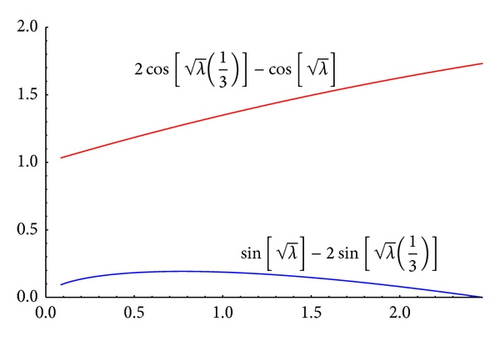
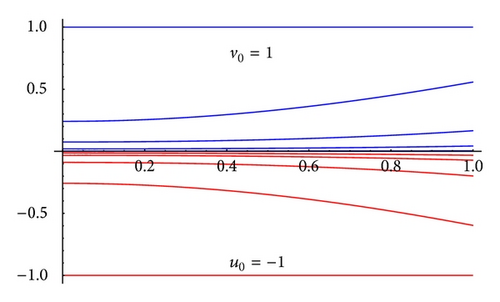
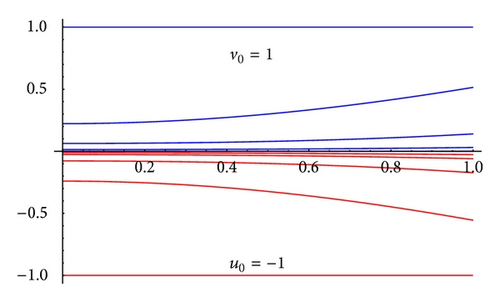
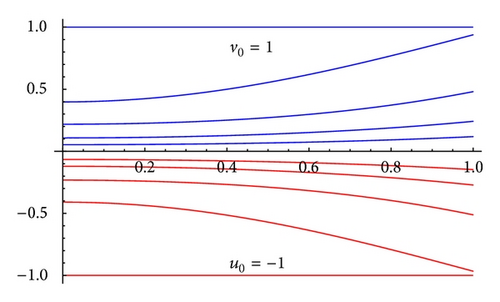
Example 11 (well order). Consider the boundary value problem
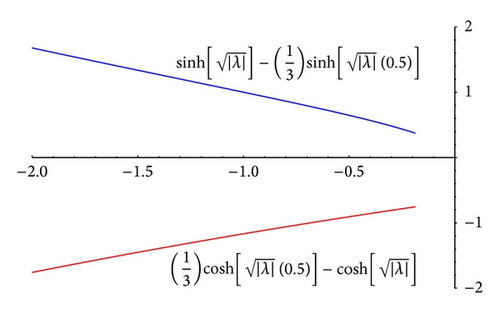
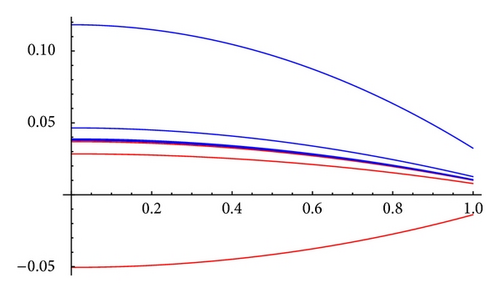
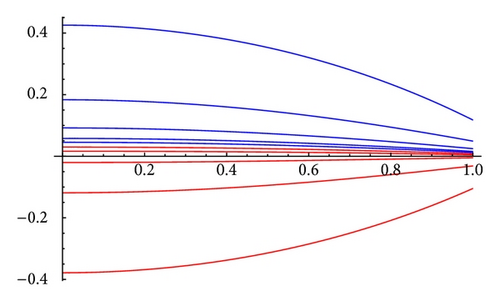
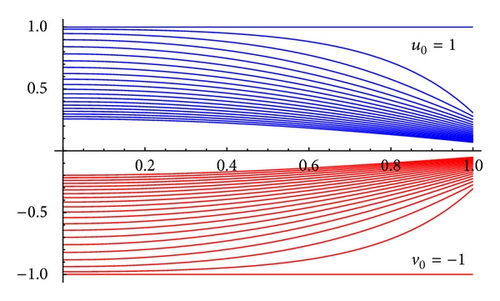
5. Conclusion
The monotone iterative technique coupled with upper and lower solutions is a powerful tool for computation of solutions of nonlinear three point boundary value problems. It proves the existence of solutions analytically and gives us a tool so that numerical solutions can also be computed and then some real-life problems, for example, bridge design problem, thermostat problem, and so forth, can be solved. We have plotted sequences for both λ > 0 and λ < 0. The plots are quite encouraging and will motivate researchers to explore further possibilities. Employing this technique, Mathematica/Maple/MATLAB user-friendly packages can be developed (see [16]).
Acknowledgment
This work is partially supported by Grant provided by UGC, New Delhi, India, File no. F.4-1/2006 (BSR)/7-203/2009(BSR).




